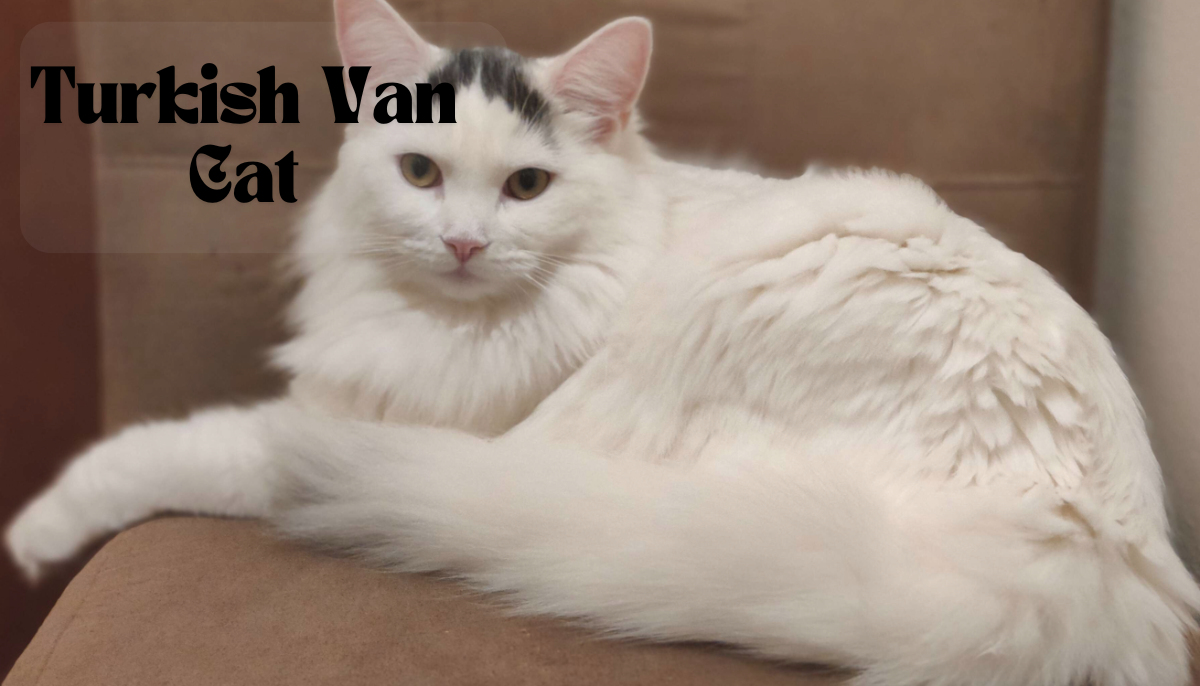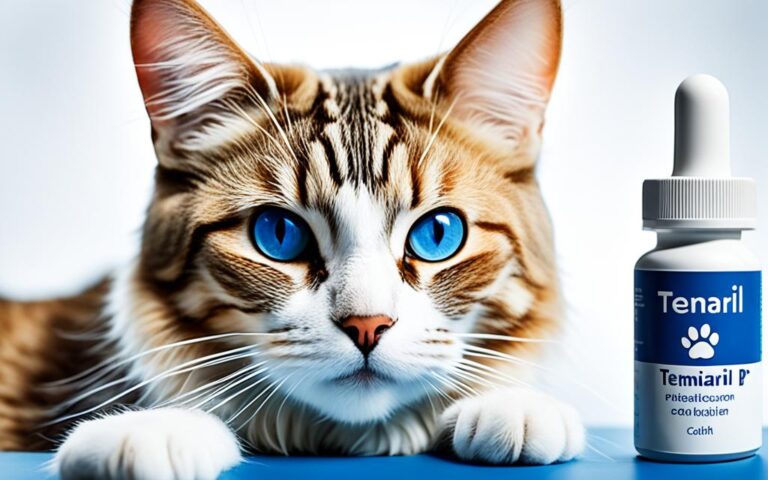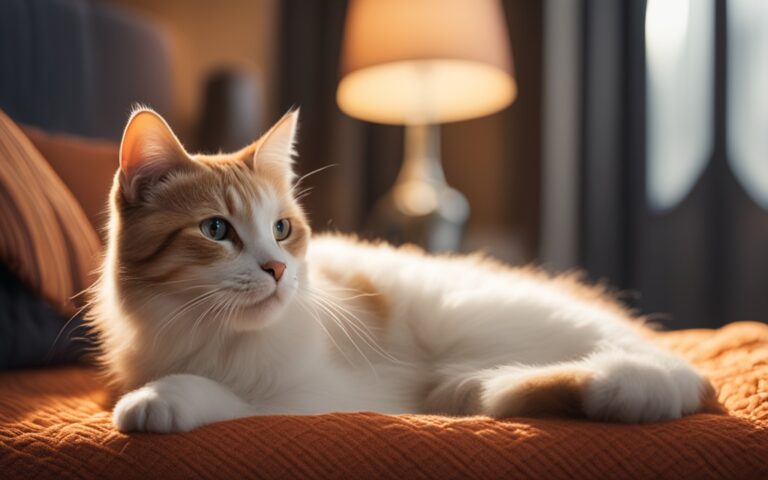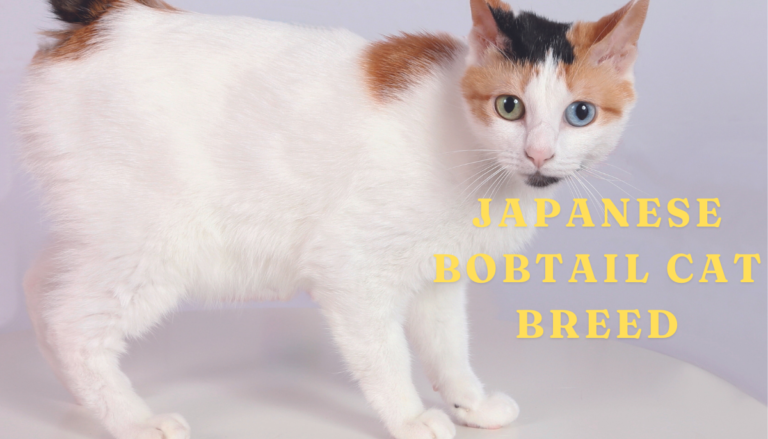Turkish Van Cat
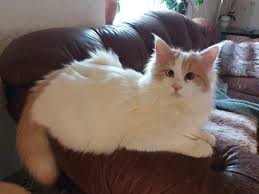
I. Introduction to the Turkish Van Cat
Meet the Turkish Van Cat, a breed as captivating as its name suggests. Originating from the rugged terrain of Turkey, this feline is named after the region where it was first discovered, the Lake Van area. Renowned for its striking appearance and distinct personality traits, the Turkish Van has garnered attention worldwide.
What sets this breed apart are its remarkable features. Sporting a semi-long, silky coat that’s predominantly white with distinct color markings on the head and tail, the Turkish Van’s appearance is truly eye-catching. One of its most notable characteristics is its captivating amber or blue eyes, which often add to its allure.
In addition to its stunning looks, the Turkish Van is celebrated for its playful and affectionate nature. Unlike some other breeds, the Turkish Van is known for its love of water, earning it the nickname “swimming cat.” With its playful antics and affectionate demeanor, this breed forms strong bonds with its human companions, making it a beloved addition to any household.
Table of Contents
II. Origins and Historical Significance:
The Turkish Van Cat’s history is as rich and intriguing as its striking appearance. Hailing from the rugged terrain of eastern Turkey, specifically the region surrounding Lake Van, this breed has a long and storied past dating back centuries.
Geographical Region of Origin:
The Lake Van area, nestled in the picturesque landscapes of Turkey, serves as the ancestral home of the Turkish Van Cat. Situated at an elevation of over 5,000 feet, this region is characterized by its harsh climate and rugged terrain. It’s amidst this unforgiving environment that the Turkish Van Cat thrived, adapting to its surroundings and developing unique traits that set it apart from other breeds.
Influences on Characteristics:
The geographical isolation of the Lake Van area played a pivotal role in shaping the characteristics of the Turkish Van Cat. Surviving in such a challenging environment required resilience and adaptability, traits that are reflected in the breed’s sturdy build and independent nature. Additionally, the breed’s proximity to water sources, including Lake Van itself, likely contributed to its affinity for swimming—a trait that distinguishes it from many other domestic cat breeds.
Folklore and Legends:
The Turkish Van Cat is steeped in folklore and legends that have been passed down through generations. One such tale involves the belief that these cats were favored by the ancient inhabitants of the region for their prowess as hunters and protectors of grain stores. According to legend, Turkish Van Cats were even said to possess supernatural abilities, with some stories suggesting they could ward off evil spirits and bring good luck to their owners. While the exact origins of the Turkish Van Cat remain shrouded in mystery, its historical significance and enduring popularity are undeniable.
III. Physical Characteristics of the Turkish Van Cat
A. Table about the Turkish Van Cat breed
| Field | Information |
|---|---|
| Height | Medium to Large |
| Weight | 10-18 pounds |
| Life Span | 12-17 years |
| Good with | Children, other pets |
| Temperament | Affectionate, playful |
| Intelligence | High |
| Shedding Amount | Moderate |
| Grooming | Low |
| Exercise Needs | Moderate |
| Energy Level | High |
| Drool Amount | Low |
| Coat Length/Texture | Semi-long, silky |
| Colors | Mostly white |
| Patterns | Van pattern, color on head and tail |
Let’s delve into the detailed characteristics of the Turkish Van Cat:
Height: The Turkish Van is a medium to large-sized breed, with males typically being larger than females. They have a robust build with muscular bodies, giving them a sturdy appearance.
Weight: Turkish Van Cats usually weigh between 10 to 18 pounds when fully grown. As with many breeds, males tend to be larger and heavier than females.
Life Span: With proper care and attention, Turkish Van Cats can live relatively long lives, ranging from 12 to 17 years on average. Providing a balanced diet, regular veterinary check-ups, and plenty of mental and physical stimulation can contribute to their longevity.
Good with: Turkish Van Cats are known for their affectionate and sociable nature, making them excellent companions for families with children and other pets. They often form strong bonds with their human family members and enjoy being included in household activities.
Temperament: Renowned for their playful and outgoing personalities, Turkish Van Cats are often described as spirited and adventurous. They possess a curious nature and enjoy exploring their surroundings. Despite their independent streak, they are also affectionate and enjoy spending time with their human companions.
Intelligence: Turkish Van Cats are highly intelligent and quick learners. They are known for their problem-solving abilities and can be trained to perform tricks or respond to commands with proper positive reinforcement techniques.
Shedding Amount: While not considered heavy shedders, Turkish Van Cats do shed moderately throughout the year. Regular grooming can help minimize shedding and keep their coat in optimal condition.
Grooming: Despite their semi-long coat, Turkish Van Cats require relatively low grooming maintenance. Weekly brushing to remove loose hair and prevent matting is usually sufficient to keep their coat healthy and tangle-free.
Exercise Needs: Turkish Van Cats have moderate exercise needs and enjoy both indoor and outdoor activities. Providing interactive toys, scratching posts, and opportunities for play can help fulfill their exercise requirements and prevent boredom.
Energy Level: Turkish Van Cats are known for their high energy levels and love of play. They thrive in environments where they have ample space to run, climb, and explore.
Drool Amount: Turkish Van Cats typically exhibit minimal drooling compared to some other breeds, making them a suitable choice for individuals who prefer a clean and tidy pet.
Coat Length/Texture: The Turkish Van’s coat is semi-long and silky, with a soft texture that is pleasant to the touch. Their fur is slightly longer around the neck, chest, and tail, giving them a distinctive appearance.
Colors: The Turkish Van Cat is predominantly white, with color markings typically found on the head and tail. These markings can come in various colors, including red, cream, black, or blue.
Patterns: The most common pattern seen in Turkish Van Cats is the “Van” pattern, characterized by color markings on the head and tail, with the rest of the body being mostly white. This unique pattern is a hallmark of the breed and adds to its charm and allure.
By understanding these detailed characteristics, prospective owners can gain insight into what to expect when welcoming a Turkish Van Cat into their home.
B. Exploring the Turkish Van Cat: Size, Coat, and Color Variations
Size:
The Turkish Van Cat is a breed known for its medium to large size, exhibiting a sturdy and muscular build. Males typically weigh between 10 to 18 pounds, while females generally range from 7 to 12 pounds. In terms of height, Turkish Van Cats typically stand around 9 to 10 inches tall at the shoulder.
Coat Type:
The coat of the Turkish Van Cat is semi-long, with a soft and silky texture that’s pleasant to the touch. Unlike some other long-haired breeds, the Turkish Van’s coat lacks an undercoat, which contributes to its unique feel and appearance. This lack of an undercoat also means that Turkish Van Cats are less prone to matting and tangling, making grooming sessions more manageable.
Color Variations:
While the Turkish Van Cat is predominantly white, it often features distinctive color markings on the head and tail. These markings can come in various shades, including red, cream, black, or blue. The most common color patterns seen in Turkish Van Cats include:
- Van Pattern: This pattern is characterized by color markings on the head and tail, with the rest of the body being predominantly white. The color markings on the head often resemble a cap, while the tail may have a colored “thumbprint” at the base.
- Bi-color: Some Turkish Van Cats may exhibit a bi-color pattern, with larger color patches on the body in addition to the markings on the head and tail. These patches can vary in shape and size, adding to the cat’s unique appearance.
Coat Texture and Length:
The coat of the Turkish Van Cat is soft, silky, and luxurious to the touch. While semi-long, the length of the coat is slightly longer around the neck, chest, and tail, giving the cat a distinctive look. Despite its longer length, the coat is relatively easy to maintain and requires minimal grooming compared to some other long-haired breeds.
Measurement and Weight Ranges:
As mentioned earlier, Turkish Van Cats typically weigh between 10 to 18 pounds for males and 7 to 12 pounds for females. In terms of height, these cats usually stand around 9 to 10 inches tall at the shoulder when fully grown.
Unique Physical Traits of the Turkish Van Cat
The Turkish Van Cat is not only renowned for its striking appearance but also for its distinctive physical features that set it apart from other breeds. Let’s explore some of these unique traits in detail:
- Van Pattern: One of the most defining features of the Turkish Van Cat is its Van pattern. This pattern typically consists of color markings on the head and tail, with the rest of the body being predominantly white. The color markings on the head often resemble a cap, while the tail may have a colored “thumbprint” at the base. This distinctive pattern adds to the cat’s allure and sets it apart from other breeds.
- Colored Eyes: Turkish Van Cats are known for their captivating eyes, which can come in various shades of amber or blue. It’s not uncommon for these cats to have heterochromatic eyes, meaning each eye is a different color—a trait that further adds to their unique appearance.
- Water-Loving Nature: Unlike many other domestic cat breeds, Turkish Van Cats have a remarkable affinity for water. They are excellent swimmers and are often dubbed as the “swimming cats” of the feline world. This love of water is believed to be an adaptation to their native environment, where they had to navigate around the numerous bodies of water in the Lake Van region.
- Bushy Tail: Another distinctive feature of the Turkish Van Cat is its bushy tail, which is often described as resembling a plume. The tail is long and lush, adding to the cat’s overall elegant appearance. When the cat is in motion, the tail is often held upright, giving it a regal and majestic air.
- Tufted Ears: Turkish Van Cats are known for their tufted ears, which are adorned with small tufts of fur at the tips. These tufts add to the cat’s charm and give it a distinctive look. While the purpose of these tufts is largely ornamental, they are believed to have served a practical function in the cat’s ancestral environment, helping to protect the ears from debris and insects.
- Athletic Build: Turkish Van Cats have a robust and athletic build, with well-developed muscles that give them strength and agility. This athleticism is evident in their graceful movements and agile reflexes, making them excellent hunters and climbers.
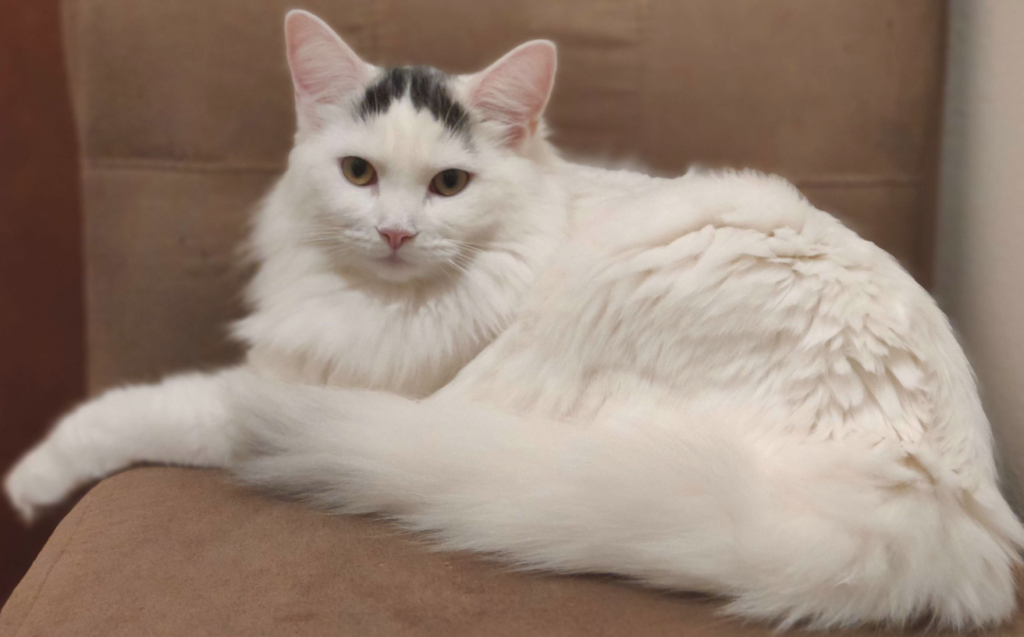
IV. Temperament and Personality Traits of the Turkish Van Cat
The Turkish Van Cat is renowned for its unique temperament and distinctive personality traits, making it a fascinating companion for feline enthusiasts. Let’s delve into the typical temperament and behaviors associated with this breed:
- Playful and Energetic: Turkish Van Cats are known for their boundless energy and playful demeanor. They have a natural curiosity and love to explore their surroundings, often engaging in playful antics that entertain their human companions.
- Affectionate and Social: Despite their independent nature, Turkish Van Cats are highly sociable and enjoy the company of their human family members. They form strong bonds with their owners and are often described as affectionate and loving pets. Many Turkish Van Cats enjoy cuddling and will seek out opportunities to be close to their favorite people.
- Intelligent and Inquisitive: Turkish Van Cats are highly intelligent and possess keen problem-solving skills. They enjoy mental stimulation and thrive in environments where they can engage in interactive play and puzzle-solving activities. Their inquisitive nature means they may investigate new objects or environments with enthusiasm.
- Vocal and Communicative: Turkish Van Cats are known for their vocal nature and are not shy about expressing themselves through meows, chirps, and other vocalizations. They may use their voice to communicate their needs or desires, making them effective communicators with their human companions.
Common Behavioral Traits:
While Turkish Van Cats are generally well-rounded and adaptable pets, there are some behavioral traits commonly associated with the breed:
- Strong Hunting Instinct: Like many cats, Turkish Van Cats have a strong hunting instinct. They may display behaviors such as stalking, pouncing, and chasing, especially when presented with small prey or toys that mimic prey-like movements.
- Independent Streak: Despite their affectionate nature, Turkish Van Cats also value their independence. They may enjoy spending time alone or engaging in solitary activities such as grooming or exploring their environment.
- Water Fascination: One of the most unique behavioral traits of the Turkish Van Cat is its fascination with water. These cats are often drawn to water sources and may enjoy activities such as playing in sinks or bathtubs, or even swimming in pools or bodies of water.
Managing Breed-Specific Behavior Issues:
While many of the Turkish Van Cat’s behavioral traits are endearing, some owners may encounter challenges related to their cat’s independent nature or strong hunting instinct. Here are some tips for managing and addressing breed-specific behavior issues:
- Provide Mental and Physical Stimulation: Keep your Turkish Van Cat mentally and physically engaged by providing plenty of interactive toys, puzzle feeders, and opportunities for play. This will help satisfy their natural curiosity and prevent boredom-related behaviors.
- Establish a Routine: Turkish Van Cats thrive on routine and consistency. Establish a regular feeding schedule, playtime routine, and designated sleeping areas to help your cat feel secure and comfortable in their environment.
- Encourage Positive Behaviors: Use positive reinforcement techniques such as praise, treats, and rewards to encourage desired behaviors in your Turkish Van Cat. This will help reinforce good habits and discourage unwanted behaviors over time.
- Provide Adequate Supervision: If your Turkish Van Cat enjoys outdoor access, be sure to provide adequate supervision to ensure their safety. This may include supervising outdoor playtime or installing a secure outdoor enclosure to prevent escape attempts.
V. Care and Maintenance of the Turkish Van Cat
A. Grooming Needs
Grooming is an essential aspect of caring for your Turkish Van Cat, ensuring their coat remains healthy, shiny, and free from tangles or mats. Let’s explore the grooming needs of this unique breed and provide tips to keep your Turkish Van looking their best:
Coat Care and Hygiene:
The semi-long, silky coat of the Turkish Van Cat requires regular maintenance to keep it in optimal condition. While these cats are relatively low-maintenance compared to some other long-haired breeds, they still benefit from consistent grooming to prevent matting and remove loose hair.
Brushing Frequency:
To maintain their coat’s luster and manage shedding, Turkish Van Cats should be brushed at least two to three times a week. During shedding seasons, such as spring and fall, more frequent brushing may be necessary to remove loose hair and prevent it from accumulating in your home.
Grooming Tools:
When it comes to grooming your Turkish Van Cat, choosing the right tools is essential. A high-quality slicker brush or a grooming glove can be effective for removing loose hair and preventing mats. Additionally, a stainless steel comb with wide and narrow teeth can help detangle any knots or mats gently.
Recommendations for Accessories and Care Products:
- Slicker Brush: A slicker brush with fine, wire bristles is ideal for removing loose hair and detangling the Turkish Van’s coat without causing discomfort.
- Grooming Glove: A grooming glove offers a gentle way to remove loose hair while providing your cat with a soothing massage.
- Stainless Steel Comb: A stainless steel comb with both wide and narrow teeth is perfect for detangling knots and mats in the Turkish Van’s semi-long coat.
- Waterless Shampoo: Consider using a waterless shampoo formulated for cats to keep your Turkish Van’s coat clean and fresh between baths.
- Ear Cleaner: Regularly cleaning your cat’s ears with a gentle ear cleaner can help prevent wax buildup and reduce the risk of ear infections.
- Nail Clippers: Keeping your cat’s nails trimmed is essential for their health and comfort. Invest in a pair of cat-specific nail clippers to safely trim your Turkish Van’s nails.
- Harness and Leash: If you plan to take your Turkish Van Cat outdoors, consider investing in a comfortable harness and leash designed for cats. This will allow you to safely explore the great outdoors together while keeping your cat secure.
- Interactive Toys: Turkish Van Cats are highly intelligent and enjoy mental stimulation. Provide your cat with interactive toys such as puzzle feeders or feather wands to keep them entertained and engaged.
By incorporating regular grooming into your Turkish Van Cat’s care routine and using the appropriate tools and products, you can ensure that your feline friend’s coat remains healthy and beautiful. With a little time and effort, grooming can be a bonding experience between you and your Turkish Van Cat, fostering trust and strengthening your relationship.
B. Health Considerations of the Turkish Van Cat
Taking proactive steps to safeguard the health and well-being of your Turkish Van Cat is paramount to ensuring a long and happy life. Let’s explore some essential health considerations, common health problems, preventive measures, and tips for promoting optimal health for your feline companion:
Genetic Health Considerations:
While Turkish Van Cats are generally robust and healthy breeds, like all cats, they may be prone to certain genetic health issues. One notable condition that can affect Turkish Van Cats is Hypertrophic Cardiomyopathy (HCM), a form of heart disease that can lead to heart failure if left untreated. Responsible breeders will screen their breeding cats for HCM to reduce the risk of passing on this condition to their offspring.
Common Health Problems:
In addition to HCM, Turkish Van Cats may be susceptible to other health issues commonly seen in domestic cats, including:
- Dental Problems: Dental issues such as periodontal disease and tooth decay can affect Turkish Van Cats, especially as they age. Regular dental care, including tooth brushing and dental check-ups, can help prevent dental problems and maintain oral health.
- Obesity: Turkish Van Cats are known for their hearty appetites, which can predispose them to obesity if not managed carefully. Obesity can lead to a variety of health problems, including diabetes, arthritis, and heart disease. Monitoring your cat’s diet, providing regular exercise, and avoiding overfeeding are essential for maintaining a healthy weight.
- Urinary Tract Issues: Some Turkish Van Cats may be prone to urinary tract problems, such as urinary tract infections or blockages. Providing plenty of fresh water, feeding a balanced diet, and ensuring access to clean litter boxes can help reduce the risk of urinary tract issues.
Recommended Veterinary Care:
Regular veterinary check-ups are crucial for monitoring your Turkish Van Cat’s health and detecting any potential issues early on. During these check-ups, your veterinarian will perform a thorough physical examination, administer any necessary vaccinations, and discuss preventive care measures tailored to your cat’s individual needs.
Preventive Measures:
In addition to regular veterinary care, there are several preventive measures you can take to promote your Turkish Van Cat’s overall health and well-being:
- Vaccinations: Keeping your cat up-to-date on vaccinations is essential for protecting them against common infectious diseases, including rabies, feline distemper, and feline leukemia virus.
- Parasite Prevention: Regularly deworming your cat and providing flea and tick prevention are essential for keeping parasites at bay. Your veterinarian can recommend safe and effective parasite prevention products for your Turkish Van Cat.
- Balanced Diet: Feeding your cat a high-quality, balanced diet that meets their nutritional needs is essential for promoting overall health and preventing obesity and other diet-related health problems.
Average Lifespan and Tips for Promoting Longevity:
On average, Turkish Van Cats have a lifespan of 12 to 17 years or more with proper care and attention. To promote a longer and healthier life for your Turkish Van Cat, consider the following tips:
- Provide a Safe Environment: Creating a safe and stimulating environment for your cat indoors can help protect them from outdoor hazards such as traffic, predators, and infectious diseases.
- Regular Exercise: Encouraging regular exercise through interactive play and providing opportunities for climbing and exploring can help keep your Turkish Van Cat physically fit and mentally stimulated.
- Emotional Well-Being: Pay attention to your cat’s emotional well-being and provide plenty of love, attention, and mental stimulation to prevent boredom and loneliness.
- Spaying or Neutering: Having your Turkish Van Cat spayed or neutered can not only prevent unwanted litters but also reduce the risk of certain health problems and behavioral issues.
C. Nutrition Needs of the Turkish Van Cat
Providing your Turkish Van Cat with a balanced and nutritious diet is essential for promoting their overall health and well-being. Let’s explore some tips for feeding your Turkish Van Cat, including dietary recommendations based on their size, age, and activity level, as well as considerations for any dietary restrictions or allergies:
Choose a High-Quality Cat Food:
When selecting a cat food for your Turkish Van, opt for high-quality, commercially available cat food that is formulated to meet the nutritional needs of cats. Look for products that feature real meat as the primary ingredient and are free from artificial preservatives, colors, and flavors.
Consider Your Cat’s Size, Age, and Activity Level:
The dietary needs of Turkish Van Cats can vary depending on factors such as their size, age, and activity level. As a medium to large-sized breed, Turkish Van Cats may require more calories and nutrients compared to smaller breeds. Additionally, kittens, adult cats, and senior cats have different nutritional requirements, so be sure to choose a cat food that is appropriate for your cat’s life stage.
Provide Balanced Nutrition:
Ensure that your Turkish Van Cat’s diet includes a balance of protein, fat, carbohydrates, vitamins, and minerals. Protein is particularly important for cats, as they are obligate carnivores and require a diet rich in animal-based protein sources to thrive. Look for cat foods with a protein content of at least 30% to meet your cat’s dietary needs.
Watch for Dietary Restrictions or Allergies:
While Turkish Van Cats are not known to have specific dietary restrictions or allergies, it’s essential to monitor your cat’s reaction to new foods and ingredients. Some cats may be sensitive to certain ingredients, such as grains or dairy products, so be observant of any signs of digestive upset or allergic reactions.
Feeding Schedule and Portion Control:
Establishing a regular feeding schedule and practicing portion control are essential for maintaining your Turkish Van Cat’s weight and overall health. Divide your cat’s daily food intake into several small meals throughout the day to prevent overeating and promote healthy digestion. Monitor your cat’s body condition and adjust their portion sizes as needed to maintain a healthy weight.
Provide Fresh Water:
Ensure that your Turkish Van Cat has access to fresh, clean water at all times. Hydration is crucial for maintaining kidney health and overall well-being, so be sure to refresh your cat’s water bowl regularly and consider investing in a water fountain to encourage drinking.

D. Exercise for the Turkish Van Cat
Regular exercise is essential for maintaining your Turkish Van Cat’s physical and mental well-being. As an active and energetic breed, Turkish Van Cats benefit from a variety of physical activities to keep them engaged and stimulated. Let’s create a detailed exercise plan tailored to the unique needs of the Turkish Van Cat:
Types of Exercise:
- Playtime: Engage your Turkish Van Cat in interactive play sessions using toys such as feather wands, laser pointers, or interactive puzzle toys. These activities mimic hunting behaviors and provide mental stimulation, helping to satisfy your cat’s natural instincts.
- Climbing and Perching: Turkish Van Cats enjoy climbing and exploring vertical spaces. Provide your cat with access to cat trees, shelves, or window perches where they can climb, jump, and observe their surroundings.
- Puzzle Feeders: Incorporate puzzle feeders or treat-dispensing toys into your Turkish Van Cat’s daily routine to encourage mental stimulation and physical activity. These toys require your cat to work for their food, providing both physical and mental exercise.
- Agility Training: Turkish Van Cats are intelligent and agile, making them well-suited for agility training activities. Set up an obstacle course with tunnels, ramps, and hurdles for your cat to navigate, rewarding them with treats or praise for completing each challenge.
Duration and Frequency:
The amount of exercise your Turkish Van Cat needs will depend on factors such as their age, health, and activity level. Aim for at least 20 to 30 minutes of active play or exercise sessions each day to keep your cat physically and mentally stimulated.
Break up exercise sessions throughout the day to prevent boredom and ensure that your cat receives regular opportunities for activity. Consider incorporating short play sessions or interactive activities into your cat’s daily routine, such as morning and evening playtimes or interactive feeding sessions.
Turkish Van Cat’s Specific Exercise Needs:
Turkish Van Cats are known for their love of water and agility, so consider incorporating water-based activities or agility training into their exercise routine. Provide opportunities for your cat to play with water, such as shallow water bowls or supervised swimming sessions in a bathtub or kiddie pool.
Additionally, Turkish Van Cats enjoy climbing and perching, so provide plenty of vertical spaces for your cat to explore and climb. Cat trees, shelves, and window perches are excellent options for encouraging climbing and jumping behaviors.
As with any exercise plan, it’s essential to monitor your Turkish Van Cat’s response and adjust the intensity and duration of activities as needed. Be observant of signs of fatigue or discomfort, and always provide plenty of opportunities for rest and relaxation.
VI. Suitability for Families and Other Pets to the Turkish Van Cat
A. Compatibility with Children and Other Animals:
Turkish Van Cats are renowned for their affectionate and sociable nature, making them excellent companions for families with children and other pets. Their playful demeanor and love of attention make them well-suited for households with active children who enjoy interactive play. Turkish Van Cats are typically tolerant of gentle handling and can form strong bonds with children, becoming loyal and devoted family members.
When introducing a Turkish Van Cat to children, it’s essential to teach them how to interact with the cat respectfully and gently. Encourage children to approach the cat calmly and avoid pulling on their tail or fur. Supervise interactions between young children and cats to ensure the safety and well-being of both parties.
In multi-pet households, Turkish Van Cats generally get along well with other pets, including dogs and other cats. Their friendly and outgoing nature makes them adaptable to new environments and social situations. However, it’s essential to introduce new pets gradually and supervise their interactions until they become comfortable with each other. Provide each pet with their own space and resources, such as food and water bowls, litter boxes, and sleeping areas, to prevent conflicts and promote harmony in the household.
B. Special Considerations for Multi-Pet Households:
When introducing a Turkish Van Cat to existing pets, take gradual steps to facilitate positive interactions and reduce stress. Start by allowing the pets to become familiar with each other’s scents by exchanging bedding or toys before introducing them face-to-face. Supervise their initial interactions closely and intervene if any signs of aggression or discomfort arise.
Provide each pet with their own space and resources to prevent territorial disputes and promote a sense of security. This may include separate feeding areas, litter boxes, and resting spots. Be patient and give your pets time to adjust to each other’s presence, offering plenty of praise, treats, and reassurance along the way.
C. Environmental Needs:
Turkish Van Cats are adaptable to a variety of living environments but thrive in homes that provide plenty of space for exploration and play. They enjoy having access to vertical spaces where they can climb, jump, and observe their surroundings. Consider providing your Turkish Van Cat with cat trees, shelves, or window perches to satisfy their natural instincts and keep them mentally stimulated.
While Turkish Van Cats can tolerate a range of temperatures, they prefer a comfortable and stable indoor environment. Ensure that your home is kept at a moderate temperature year-round and provide your cat with cozy spots to relax and rest. Avoid exposing your cat to extreme temperatures or drafts, as this can lead to discomfort or health issues.
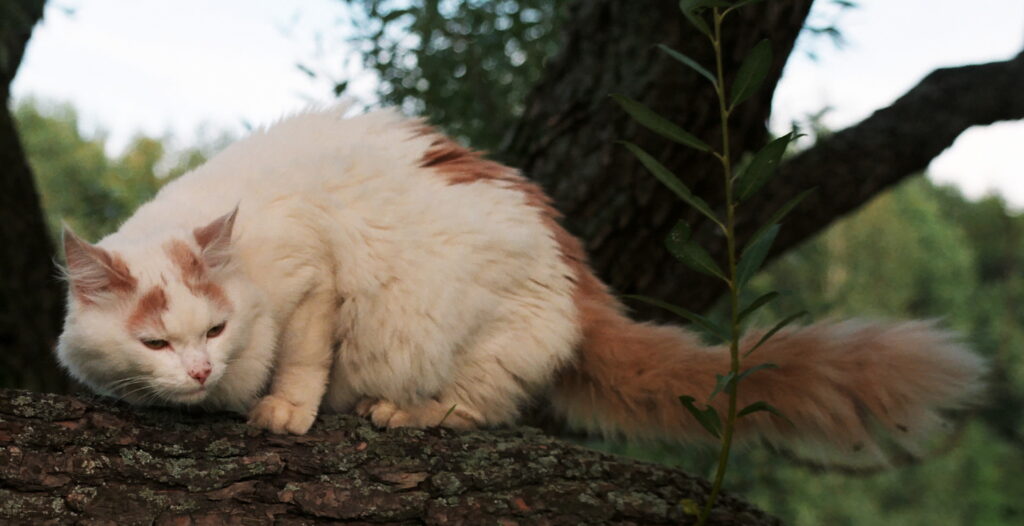
VII. Adoption and Breeder Considerations for the Turkish Van Cat
A. The Benefits of Adoption:
Adopting a Turkish Van Cat from a shelter or rescue organization can be a rewarding experience for both you and the cat in need of a loving home. Here are some key benefits of adopting a Turkish Van Cat:
- Saving a Life: By adopting from a shelter or rescue organization, you are giving a second chance to a cat in need. Many cats in shelters are abandoned or surrendered due to unforeseen circumstances, and adopting them gives them the opportunity to live a happy and fulfilling life with a caring family.
- Finding the Perfect Match: Shelters and rescue organizations often have a variety of cats available for adoption, including Turkish Van Cats. Adopting from a shelter allows you to meet and interact with different cats to find the perfect match for your lifestyle and preferences.
- Supporting a Good Cause: When you adopt a cat from a shelter or rescue organization, you are supporting their mission to rescue, rehabilitate, and rehome homeless pets. Your adoption fee helps cover the cost of caring for the cat while they are in the shelter, as well as supporting other animals in need.
- Health and Behavior Assessment: Many shelters and rescue organizations conduct health and behavior assessments on their animals to ensure they are healthy and well-socialized before being adopted. This can provide peace of mind knowing that your new cat has been thoroughly vetted and is ready to become a beloved member of your family.
- Building a Bond: Adopting a cat from a shelter or rescue organization allows you to build a special bond with your new pet based on love, trust, and mutual respect. Knowing that you have provided a loving home for a cat in need can deepen your connection and create a lifelong friendship.
Overall, adopting a Turkish Van Cat from a shelter or rescue organization is a wonderful way to make a positive impact on the life of a homeless pet while gaining a loyal and loving companion in return. Consider visiting your local shelter or rescue organization to see the cats available for adoption and take the first step towards finding your perfect feline friend.
B. Breeder Considerations:
If you decide to purchase a Turkish Van Cat from a breeder, it’s essential to choose a reputable breeder who prioritizes the health and well-being of their cats. Here are some key considerations when selecting a breeder:
- Health Testing: Look for breeders who conduct health testing on their breeding cats to screen for genetic conditions such as Hypertrophic Cardiomyopathy (HCM). Responsible breeders will provide documentation of health testing results and offer health guarantees for their kittens.
- Socialization and Care: Choose a breeder who prioritizes early socialization and provides a nurturing environment for their kittens. Kittens should be raised in a clean and loving home environment, where they are exposed to various stimuli and interactions with humans and other animals.
- Breeding Practices: Research the breeder’s breeding practices and ask about their breeding philosophy and goals. A reputable breeder will breed for health, temperament, and adherence to the breed standard, rather than prioritizing profit or quantity over quality.
- References and Reviews: Seek recommendations from other cat owners or breed enthusiasts who have experience with the breeder. Reading reviews and testimonials from previous customers can provide insight into the breeder’s reputation and the quality of their cats.
- Contract and Support: Choose a breeder who provides a written contract outlining the terms of the sale, including health guarantees, spay/neuter agreements, and return policies. Reputable breeders will offer ongoing support and guidance to new kitten owners throughout the cat’s life.
B. Selecting a Reputable Turkish Van Cat Breeder: Ethical Practices and Health Screenings
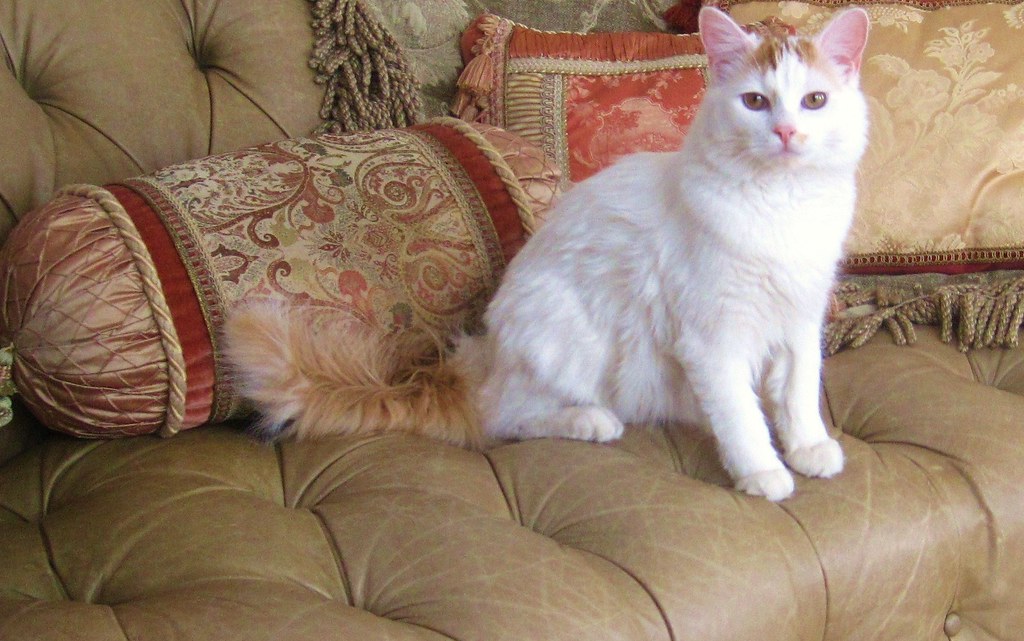
When considering purchasing a Turkish Van Cat from a breeder, it’s crucial to choose a reputable breeder who prioritizes the health and well-being of their cats. Here’s a guide to help you select a responsible breeder and ensure that your new kitten comes from a reputable and ethical source:
- Research Breeders:
Start by researching breeders who specialize in Turkish Van Cats. Look for breeders who have a solid reputation within the cat breeding community and who are recognized for their commitment to ethical breeding practices and the health of their cats.
- Visit Breeding Facilities:
Arrange to visit the breeding facilities of potential breeders in person. This will give you the opportunity to see the conditions in which the cats are raised and assess the breeder’s dedication to providing a clean, safe, and nurturing environment for their cats and kittens.
- Ask Questions:
Don’t be afraid to ask questions when speaking with breeders. Inquire about their breeding practices, including how often they breed their cats, how they socialize their kittens, and what steps they take to ensure the health and well-being of their cats and kittens.
- Health Screenings:
One of the most critical factors to consider when selecting a breeder is their commitment to health screenings for their breeding cats. Reputable breeders will conduct health screenings on their cats to screen for genetic conditions such as Hypertrophic Cardiomyopathy (HCM), which is known to affect Turkish Van Cats.
Ask potential breeders about the health testing protocols they follow and request documentation of health screening results for their breeding cats. A responsible breeder will be transparent about their health testing practices and will provide evidence of testing to prospective buyers.
- Breeding Philosophy:
Inquire about the breeder’s breeding philosophy and goals. A reputable breeder will breed for health, temperament, and adherence to the breed standard, rather than prioritizing profit or quantity over quality. Look for breeders who are passionate about the breed and who are dedicated to preserving its unique characteristics and qualities.
- References and Reviews:
Seek recommendations from other cat owners or breed enthusiasts who have purchased cats from the breeder in question. Reading reviews and testimonials from previous customers can provide valuable insight into the breeder’s reputation and the quality of their cats and kittens.
- Written Contract:
Ensure that the breeder provides a written contract outlining the terms of the sale, including health guarantees, spay/neuter agreements, and return policies. A reputable breeder will offer clear and transparent terms and will be willing to answer any questions you may have about the contract.
C. Financial Aspect of Adopting or Purchasing a Turkish Van Cat
When considering bringing a Turkish Van Cat into your home, it’s essential to understand the financial considerations involved in both adoption and purchase. From adoption fees to the cost of purchasing a purebred kitten, here’s a comprehensive overview to help you make an informed decision:
Adoption Fees for Turkish Van Cats:
- Shelters and Rescue Organizations: Adoption fees for Turkish Van Cats from shelters or rescue organizations typically range from $50 to $150, depending on the organization and location. These fees help cover the cost of veterinary care, vaccinations, spaying or neutering, and other expenses associated with caring for the cat while they are in the shelter’s care.
- Breed-Specific Rescues: Some rescue organizations specialize in specific breeds, including Turkish Van Cats. Adoption fees for cats from breed-specific rescues may be slightly higher than those from general shelters but often include the same services and amenities, such as veterinary care and spaying/neutering.
- Included Services: When adopting a Turkish Van Cat from a shelter or rescue organization, the adoption fee typically includes essential services such as spaying or neutering, vaccinations, microchipping, and a veterinary check-up. These services are designed to ensure the cat’s health and well-being before they are adopted into their forever home.
Cost of Purchasing a Turkish Van Cat from a Breeder:
- Purebred Turkish Van Kittens: The cost of purchasing a Turkish Van Kitten from a reputable breeder can vary depending on factors such as pedigree, lineage, and breeding standards. On average, you can expect to pay between $500 to $1500 for a Turkish Van Kitten from a responsible breeder, although prices may be higher for kittens from champion bloodlines or show-quality cats.
- Included Services: When purchasing a Turkish Van Kitten from a breeder, the cost often includes essential services such as health screenings, vaccinations, deworming, and a health guarantee. Some breeders may also provide additional amenities such as microchipping, registration papers, and a starter kit with food and toys for the kitten.
- Additional Expenses: In addition to the purchase price of the kitten, it’s essential to budget for ongoing expenses such as food, litter, grooming supplies, veterinary care, and other necessities. These costs can vary depending on factors such as your location, the quality of food and supplies you choose, and any additional services or treatments your cat may require.
Considerations for Financial Planning:
- Budgeting for Expenses: Before bringing a Turkish Van Cat into your home, take the time to assess your budget and determine how much you can comfortably afford to spend on initial adoption or purchase fees, as well as ongoing expenses such as food, litter, and veterinary care. Creating a budget can help you plan for the financial responsibilities of pet ownership and ensure that you can provide for your cat’s needs.
- Researching Available Options: Take the time to research available adoption and purchase options for Turkish Van Cats in your area. Compare adoption fees from different shelters and rescue organizations, and reach out to reputable breeders to inquire about the cost of purchasing a purebred kitten. Gathering information from multiple sources can help you make an informed decision and find the best option for your budget and preferences.
- Planning for Long-Term Care: When budgeting for a Turkish Van Cat, it’s essential to consider the long-term costs of pet ownership. Factor in expenses such as annual veterinary check-ups, vaccinations, flea and tick prevention, and emergency medical care. Setting aside funds for unexpected expenses can help you prepare for any unforeseen circumstances that may arise during your cat’s lifetime.
VIII. Conclusion
A. Key Points about the Turkish Van Cat:
In summary, the Turkish Van Cat is a unique and fascinating breed with distinctive characteristics and a charming temperament:
- Physical Characteristics: Turkish Van Cats are known for their striking appearance, with semi-longhaired coats, distinctive color patterns, and captivating amber or blue eyes. They are medium to large-sized cats with muscular bodies and tufted ears.
- Temperament: Turkish Van Cats are renowned for their playful, outgoing, and affectionate nature. They form strong bonds with their human companions and enjoy interactive play and companionship. Despite their energetic demeanor, they are also known for their gentle and laid-back temperament, making them suitable companions for families and other pets.
B. Importance of Responsible Ownership and Proper Care:
While Turkish Van Cats make wonderful companions, it’s essential to understand the responsibilities and commitments involved in caring for this breed:
- Responsible Ownership: Owning a Turkish Van Cat is a lifelong commitment that requires time, attention, and financial resources. Prospective owners should carefully consider their ability to provide a loving and nurturing home for a cat before bringing one into their lives.
- Proper Care: Turkish Van Cats thrive in environments where they receive proper care, including regular veterinary check-ups, balanced nutrition, and opportunities for mental and physical stimulation. Responsible owners should prioritize the health and well-being of their cats and provide them with a safe and enriching environment to thrive.
- Consideration of All Aspects: Before bringing a Turkish Van Cat into your home, take the time to research the breed thoroughly and consider all aspects of ownership, including financial considerations, time commitments, and lifestyle compatibility. Understanding the breed’s needs and temperament will help ensure a harmonious relationship between you and your cat.
In conclusion, the Turkish Van Cat is a beloved breed cherished for its beauty, intelligence, and affectionate nature. By embracing responsible ownership and providing proper care, prospective owners can enjoy a fulfilling and rewarding relationship with their Turkish Van Cat for many years to come. Remember to prioritize the well-being of your cat and approach ownership with dedication, patience, and love.
FAQs About the Turkish Van Cat
Are Turkish Van Cats hypoallergenic?
While no cat breed is completely hypoallergenic, Turkish Van Cats are known to produce fewer allergens than other breeds. Their semi-longhaired coats lack an undercoat, which can reduce shedding and minimize the spread of allergens. However, individual sensitivity to cat allergens can vary, so it’s essential to spend time with a Turkish Van Cat before bringing one into your home if you have allergies.
Do Turkish Van Cats enjoy swimming?
Yes, Turkish Van Cats are one of the few cat breeds known for their affinity for water. They have a natural instinct for swimming and are often referred to as “swimming cats” or “water cats.” Turkish Van Cats may enjoy playing in water or even swimming laps in a shallow pool or bathtub. However, always supervise your cat during water activities to ensure their safety.
Are Turkish Van Cats vocal?
While Turkish Van Cats are not excessively vocal compared to some other breeds, they are known to be communicative and may express themselves with a range of vocalizations, including chirps, trills, and meows. They enjoy interacting with their human companions and may vocalize to seek attention, express contentment, or communicate their needs.
Do Turkish Van Cats have any dietary preferences?
Turkish Van Cats do not have any specific dietary preferences, but they may have hearty appetites and enjoy meals rich in protein. Providing a balanced diet that meets their nutritional needs is essential for their health and well-being. Consider offering a combination of high-quality dry and wet cat food to satisfy their appetite and ensure they receive the nutrients they need.
Are Turkish Van Cats prone to any specific health issues?
While Turkish Van Cats are generally healthy and robust breeds, they may be susceptible to certain health issues, including Hypertrophic Cardiomyopathy (HCM), a form of heart disease that can affect cats. Responsible breeders conduct health screenings to identify and mitigate the risk of genetic conditions in their breeding cats. Regular veterinary check-ups and preventive care can help monitor your cat’s health and detect any potential issues early on.
How do Turkish Van Cats adapt to indoor living?
Turkish Van Cats are adaptable to indoor living environments but enjoy having access to outdoor spaces where they can explore and play. Providing plenty of enrichment, such as cat trees, toys, and interactive play sessions, can help keep Turkish Van Cats mentally and physically stimulated indoors. Additionally, offering access to a secure outdoor enclosure or supervised outdoor time can allow them to satisfy their natural curiosity and desire for exploration.

